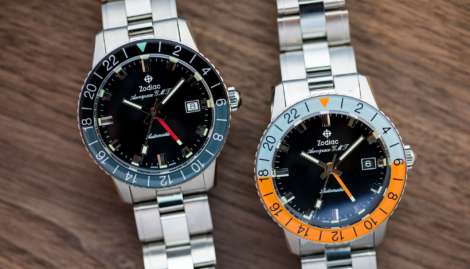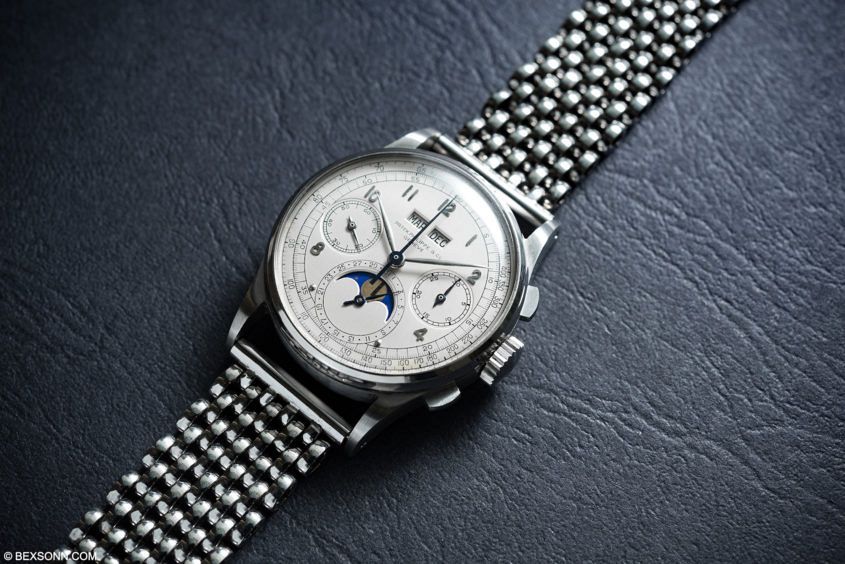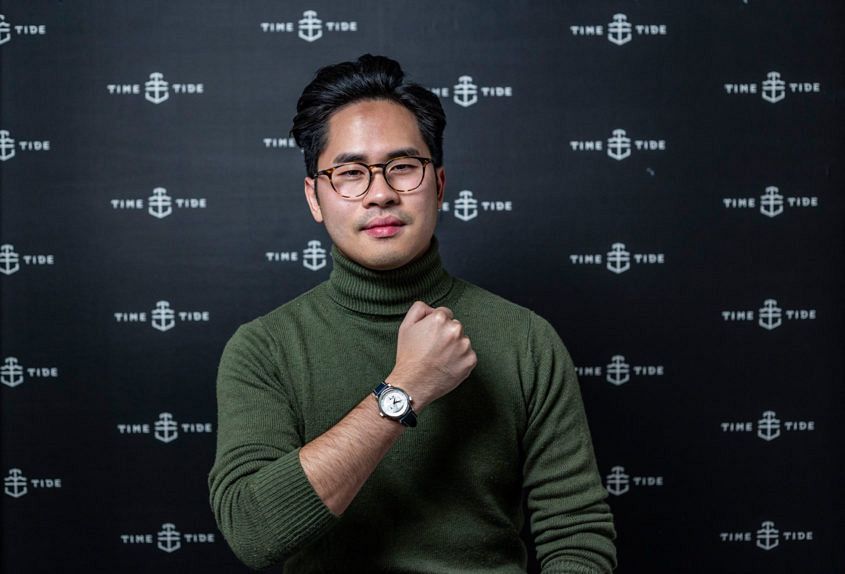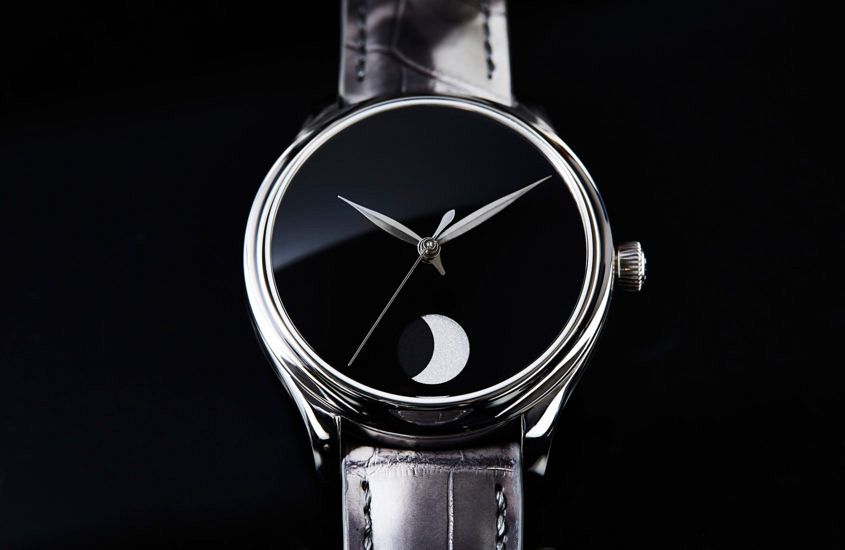The IWC Big Pilot flying higher than ever
 Editor’s note: Ergonomics have always been at the forefront of design for the IWC Big Pilot, with the large legible dial and oversized onion crown perfect for low-light cockpit conditions, and use with flight gloves. Despite this, it was a significant move when IWC took the design to a new place, with the Big Pilot Edition ‘Right-Hander’. It now features the crown on the left-hand side of the case, to avoid uncomfortable digging into the back of the hand or wrist. While we are still digesting this design update, we wanted to look back at the Big Pilot that started it all, and the cult status that it commands around the world. When IWC released their Big Pilot (reference 5002, now updated to reference 5010) in 2002 they were pioneers in the big watch game and they could hardly have known what legend they were creating. At 46mm it was a beast, an irresistible force. The deceptively simple design and concept is one that has been imitated, but never bettered. The Big Pilot makes a Big Statement, and over the years has attracted some big-name wearers. Orlando Bloom Orlando – A longtime IWC and Rolex fan (he’s often spotted with…
Editor’s note: Ergonomics have always been at the forefront of design for the IWC Big Pilot, with the large legible dial and oversized onion crown perfect for low-light cockpit conditions, and use with flight gloves. Despite this, it was a significant move when IWC took the design to a new place, with the Big Pilot Edition ‘Right-Hander’. It now features the crown on the left-hand side of the case, to avoid uncomfortable digging into the back of the hand or wrist. While we are still digesting this design update, we wanted to look back at the Big Pilot that started it all, and the cult status that it commands around the world. When IWC released their Big Pilot (reference 5002, now updated to reference 5010) in 2002 they were pioneers in the big watch game and they could hardly have known what legend they were creating. At 46mm it was a beast, an irresistible force. The deceptively simple design and concept is one that has been imitated, but never bettered. The Big Pilot makes a Big Statement, and over the years has attracted some big-name wearers. Orlando Bloom Orlando – A longtime IWC and Rolex fan (he’s often spotted with…
The post The IWC Big Pilot flying higher than ever appeared first on Time and Tide Watches.



 Alfredo Paramico doesn’t look like a watch collector. Living in Miami Beach, he looks more like an action hero, tanned like Baywatch and ripped like Schwarzenegger, and clad from head to toe in the latest designer capsules. However, in spite of this initial Wooster-esque impression, he is in fact one of the most well-known collectors of vintage watches in the world. A former merchant banker turned investor and watch dealer, he has amassed a collection worth an estimated $25 million. An offshoot of his own collecting behaviour is Elite Advisers, an investment fund devoted to collectible watches that are expected to appreciate. In an interview with Luxury Society in 2017, Alfredo Paramico discusses his fund in some depth, what he looks for when building his collection, and if there is a bubble in the vintage watch market. These comments are interesting in the context of what has happened to both the pre-owned and primary watch markets over the last 18 months, with certain models exploding in value for both markets. While the watch industry has changed more generally through these areas of growth, a collector of Alfredo Paramico’s calibre expresses a perspective that captures the mood of the moment.
Alfredo Paramico doesn’t look like a watch collector. Living in Miami Beach, he looks more like an action hero, tanned like Baywatch and ripped like Schwarzenegger, and clad from head to toe in the latest designer capsules. However, in spite of this initial Wooster-esque impression, he is in fact one of the most well-known collectors of vintage watches in the world. A former merchant banker turned investor and watch dealer, he has amassed a collection worth an estimated $25 million. An offshoot of his own collecting behaviour is Elite Advisers, an investment fund devoted to collectible watches that are expected to appreciate. In an interview with Luxury Society in 2017, Alfredo Paramico discusses his fund in some depth, what he looks for when building his collection, and if there is a bubble in the vintage watch market. These comments are interesting in the context of what has happened to both the pre-owned and primary watch markets over the last 18 months, with certain models exploding in value for both markets. While the watch industry has changed more generally through these areas of growth, a collector of Alfredo Paramico’s calibre expresses a perspective that captures the mood of the moment.
 Jonathon did not buy this watch — a stylish Jaeger-LeCoultre Master Geographic — instead, he managed to convince his grandfather to relinquish it. It was the first watch Jonathon remembers seeing and noticing that it was a *nice* watch (and honestly, it’s easy to see why). Now, it’s one thing to notice your grandfather’s watch and admire it from afar, but it’s another thing entirely to fully migrate it from his wrist to your own. But as we discovered in the latest instalment of Every Watch Tells a Story, Jonathon’s approach was surprisingly direct. I said to him, “Hey, that’s a nice watch, I don’t see you wearing it that often — I’d be very happy to take it off you and wear it for you. And he was like … sure, if you’ll wear it more, it’s yours.” The coda to the story, though, is that the watch needed a service, and with that came a case polish, which meant that the dings and marks of a life well-lived disappeared, and while Jonathon was initially disheartened at this erasure of identity, in the end he came to the realisation that it’s now his watch, and one he can put…
Jonathon did not buy this watch — a stylish Jaeger-LeCoultre Master Geographic — instead, he managed to convince his grandfather to relinquish it. It was the first watch Jonathon remembers seeing and noticing that it was a *nice* watch (and honestly, it’s easy to see why). Now, it’s one thing to notice your grandfather’s watch and admire it from afar, but it’s another thing entirely to fully migrate it from his wrist to your own. But as we discovered in the latest instalment of Every Watch Tells a Story, Jonathon’s approach was surprisingly direct. I said to him, “Hey, that’s a nice watch, I don’t see you wearing it that often — I’d be very happy to take it off you and wear it for you. And he was like … sure, if you’ll wear it more, it’s yours.” The coda to the story, though, is that the watch needed a service, and with that came a case polish, which meant that the dings and marks of a life well-lived disappeared, and while Jonathon was initially disheartened at this erasure of identity, in the end he came to the realisation that it’s now his watch, and one he can put… Editor’s note: Chanel has been making watches for a little while now, but in recent years they’ve been rocketing up the cool, and the credibility stakes. But this spirit of change and commitment doesn’t emerge from a vacuum, as Sandra discovers … It’s a paradox that a luxury house as conspicuously feminine as Chanel should always have had a gender-bending streak. So here comes a quick bit of fashion history – and before you watch geeks roll your eyes and change the channel, let me say that this will help explain everything about Chanel’s watches. Including why they are not to be dismissed as mere “fashion watches”. I’ll be brief. By the simple fact of launching herself into business (as a milliner) in 1910, Gabrielle ‘Coco’ Chanel flew in the face of expected gender roles. As she added clothes to her repertoire, she appropriated masculine elements: using jersey fabrics (previously reserved strictly for men’s underwear); putting chic women into trousers, and into the striped jumpers of Breton sailors; turning masculine tweeds into feminine jackets; and making suntans fashionable (previously, only outdoor labourers got tanned). The perfumes, too, always had an air of not-quite-conventional femininity; since the beginning (No.5 was launched…
Editor’s note: Chanel has been making watches for a little while now, but in recent years they’ve been rocketing up the cool, and the credibility stakes. But this spirit of change and commitment doesn’t emerge from a vacuum, as Sandra discovers … It’s a paradox that a luxury house as conspicuously feminine as Chanel should always have had a gender-bending streak. So here comes a quick bit of fashion history – and before you watch geeks roll your eyes and change the channel, let me say that this will help explain everything about Chanel’s watches. Including why they are not to be dismissed as mere “fashion watches”. I’ll be brief. By the simple fact of launching herself into business (as a milliner) in 1910, Gabrielle ‘Coco’ Chanel flew in the face of expected gender roles. As she added clothes to her repertoire, she appropriated masculine elements: using jersey fabrics (previously reserved strictly for men’s underwear); putting chic women into trousers, and into the striped jumpers of Breton sailors; turning masculine tweeds into feminine jackets; and making suntans fashionable (previously, only outdoor labourers got tanned). The perfumes, too, always had an air of not-quite-conventional femininity; since the beginning (No.5 was launched… Editor’s note: Without doubt, the most popular dial colour for men’s watches is black. So, here’s the blackest, darkest dial we can think of — the H. Moser & Cie Endeavour Perpetual Moon Concept. To find out why this watch is so impossibly dark of dial, read on … Few colours have the symbolic weight of black. It’s meaningful in pretty much every culture. It’s associated — naturally enough — with darkness, mourning and solemnity, and with endings and beginnings. It’s also a colour of power and authority. All these associations and emotions are tied up in Moser’s latest conceptual piece, the Endeavour Perpetual Moon Concept Vantablack. Before we get to the greater meaning of this watch, let’s talk about the purely physical: steel case, 42mm wide, in the characteristically scalloped Endeavour case. A broad exhibition caseback shows off the HMC 801, manually wound, equipped with Moser’s interchangeable escapement and good for seven days of wind as shown on the indicator on the caseback. The strap is black alligator. All this has been seen before. What hasn’t been seen is the dial. Black, and stunning in its absence. Four hands sit upon a void of nothing. Hours, minutes and seconds…
Editor’s note: Without doubt, the most popular dial colour for men’s watches is black. So, here’s the blackest, darkest dial we can think of — the H. Moser & Cie Endeavour Perpetual Moon Concept. To find out why this watch is so impossibly dark of dial, read on … Few colours have the symbolic weight of black. It’s meaningful in pretty much every culture. It’s associated — naturally enough — with darkness, mourning and solemnity, and with endings and beginnings. It’s also a colour of power and authority. All these associations and emotions are tied up in Moser’s latest conceptual piece, the Endeavour Perpetual Moon Concept Vantablack. Before we get to the greater meaning of this watch, let’s talk about the purely physical: steel case, 42mm wide, in the characteristically scalloped Endeavour case. A broad exhibition caseback shows off the HMC 801, manually wound, equipped with Moser’s interchangeable escapement and good for seven days of wind as shown on the indicator on the caseback. The strap is black alligator. All this has been seen before. What hasn’t been seen is the dial. Black, and stunning in its absence. Four hands sit upon a void of nothing. Hours, minutes and seconds…